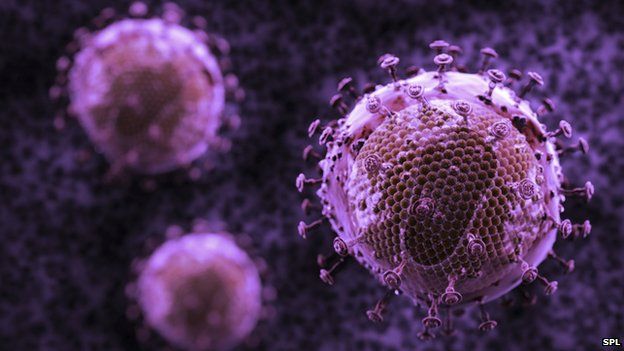'Exciting' drug flushes out HIV
- Published

Scientists say they have made an "exciting" step towards curing HIV by forcing the virus out of hiding.
HIV can become part of someone's DNA and lie dormant for decades, making a cure impossible.
Early stage research in six people, reported at the Aids 2014 conference, shows that low-dose chemotherapy can awaken the virus.
Experts said it was a promising start, but it was unlikely the drug would work on its own to cure HIV.
Anti-viral drugs can drive HIV down to undetectable levels in the bloodstream, meaning people who are HIV-positive can have a near-normal life expectancy.
But there is problem. HIV can incorporate its DNA into our own, where it lies beyond the reach of drugs and the immune system - it is known as the HIV reservoir.
When drug treatment stops, the virus can leap out of the reservoir and renew its assault.
International research is aimed at flushing the virus out of its reservoirs.
A team at Aarhaus University in Demark tried using a chemotherapy drug, romidepsin, which is used in lymphoma.
Six HIV patients with undetectable levels of the virus were enrolled into trial.
They each received a reduced dose of romidepsin once a week for three weeks.
There was a noticeable jump in viral levels in the blood in five of the patients.
One of the scientists involved, Dr Ole Sogaard, told the BBC: "Every step forward is always exciting, and I think this is quite important."
He said there had been a lot of scepticism about the drug being potent enough.
"We've shown it is possible to kick the virus out of the cells, the next step is to actually kill the cells.
"The trial now moves into a new phase which combines the romidepsin with something to enhance the immune system and in our case this is an HIV vaccine."
Side-effects were those normally associated with chemotherapy, including fatigue.
Difficult challenges
There are still many challenges ahead.
The team cannot say what proportion of cells hiding HIV are being activated by romidepsin.
Another looming question is which reservoirs are being successfully targeted. HIV can hide in immune cells in the blood, but there are bigger reservoirs in the gut and central nervous systems and it is not clear whether they are activated by the blood-based chemotherapy.
"We know it's a step forwards, but we don't know how big, it might just be a single step or it could be a great leap forward," Dr Sogaard added.
Romidepsin works by "relaxing" tight coiled up bundles of DNA. This exposes the hidden HIV genetic code and leads to the production of new viruses.
Dr Andrew Freedman, a reader in infectious diseases at Cardiff University, told the BBC: "As a proof of concept it does look promising.
"The search for a cure is very much on, it's not going to be easy and it's unlikely a single drug like this would be sufficient.
"There's a lot of doubt it would be enough to deplete the reservoir completely.
"Most people think a single approach will not be enough, a drug like this perhaps needs to be combined with vaccines or even gene-therapy."
- Published30 November 2011
- Published15 March 2013
- Published3 July 2013
- Published6 March 2014
- Published17 January 2013
- Published31 October 2013